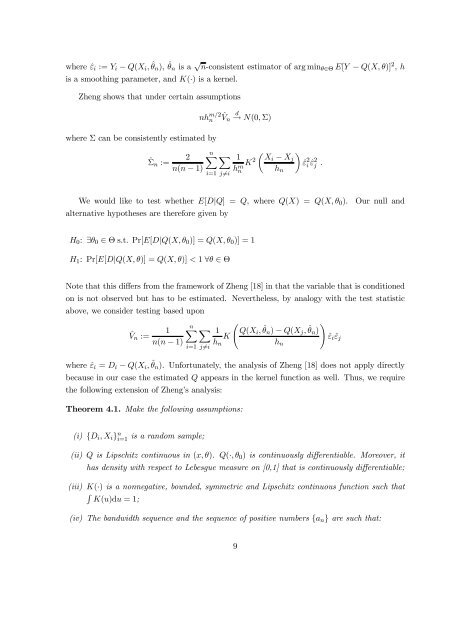On the Identification of Misspecified Propensity Scores - School of ...
On the Identification of Misspecified Propensity Scores - School of ...
On the Identification of Misspecified Propensity Scores - School of ...
Create successful ePaper yourself
Turn your PDF publications into a flip-book with our unique Google optimized e-Paper software.
where ˆεi := Yi − Q(Xi, ˆ θn), ˆ θn is a √ n-consistent estimator <strong>of</strong> arg minθ∈Θ E[Y − Q(X, θ)] 2 , h<br />
is a smoothing parameter, and K(·) is a kernel.<br />
Zheng shows that under certain assumptions<br />
where Σ can be consistently estimated by<br />
ˆΣn :=<br />
2<br />
n(n − 1)<br />
nh m/2 ˆVn n<br />
d → N(0, Σ)<br />
n <br />
1<br />
h<br />
i=1 j=i<br />
m n<br />
K 2<br />
<br />
Xi − Xj<br />
hn<br />
<br />
ˆε 2 i ˆε 2 j .<br />
We would like to test whe<strong>the</strong>r E[D|Q] = Q, where Q(X) = Q(X, θ0). Our null and<br />
alternative hypo<strong>the</strong>ses are <strong>the</strong>refore given by<br />
H0: ∃θ0 ∈ Θ s.t. Pr[E[D|Q(X, θ0)] = Q(X, θ0)] = 1<br />
H1: Pr[E[D|Q(X, θ)] = Q(X, θ)] < 1 ∀θ ∈ Θ<br />
Note that this differs from <strong>the</strong> framework <strong>of</strong> Zheng [18] in that <strong>the</strong> variable that is conditioned<br />
on is not observed but has to be estimated. Never<strong>the</strong>less, by analogy with <strong>the</strong> test statistic<br />
above, we consider testing based upon<br />
n<br />
<br />
1 1 Q(Xi,<br />
ˆVn :=<br />
K<br />
n(n − 1)<br />
ˆ θn) − Q(Xj, ˆ <br />
θn)<br />
ˆεiˆεj<br />
hn<br />
i=1 j=i<br />
where ˆεi = Di − Q(Xi, ˆ θn). Unfortunately, <strong>the</strong> analysis <strong>of</strong> Zheng [18] does not apply directly<br />
because in our case <strong>the</strong> estimated Q appears in <strong>the</strong> kernel function as well. Thus, we require<br />
<strong>the</strong> following extension <strong>of</strong> Zheng’s analysis:<br />
Theorem 4.1. Make <strong>the</strong> following assumptions:<br />
(i) {Di, Xi} n i=1 is a random sample;<br />
(ii) Q is Lipschitz continuous in (x, θ). Q(·, θ0) is continuously differentiable. Moreover, it<br />
has density with respect to Lebesgue measure on [0,1] that is continuously differentiable;<br />
(iii) K(·) is a nonnegative, bounded, symmetric and Lipschitz continuous function such that<br />
K(u)du = 1;<br />
(iv) The bandwidth sequence and <strong>the</strong> sequence <strong>of</strong> positive numbers {an} are such that:<br />
9<br />
hn
















